With a nickname like ‘The Peace Garden State’, you know that North Dakota is a bird-friendly place to be. With sculpted domes and pyramids in the Badlands, along with the lush Drift Prairie, and the beautiful Missouri Plateau you’ve got a lot of scenic spots that attract a number of diverse birds that you are going to LOVE seeing. Today we will talk a little about the popular backyard birds of North Dakota, providing you with useful information for identifying, spotting, and even luring these lovely birds in for a closer look. We’ll top it off with a little feeder advice and some hotspots around the state so now that we have piqued your interest, let’s get started!
3 Categories – 376 Birds
North Dakota is home to an impressive 376 species of birds and that is quite enough to keep a birder busy. While we can’t possibly list them all we are going to sample some of the local variety, dividing the birds up first into these categories:
- Year-round Resident birds
- Birds of Spring, Summer, and Early Fall
- Fall and Winter Birds
Once you know WHEN to look we’ll provide you with identification and dietary info and with a little luck you might just be able to lure some of your favorite birds into your own back yard. Let’s start with the year-round resident birds.
North Dakota’s Year-round Resident birds
These birds have made North Dakota their home and may be spotted at any time of the year, provided that you know where to look. See if you can spot one or more of these birds this year:
- Black-capped Chickadee
- Mourning Dove
- American Goldfinch
- Song Sparrow
- American Robin
Black-capped Chickadee – Poecile atricapillus
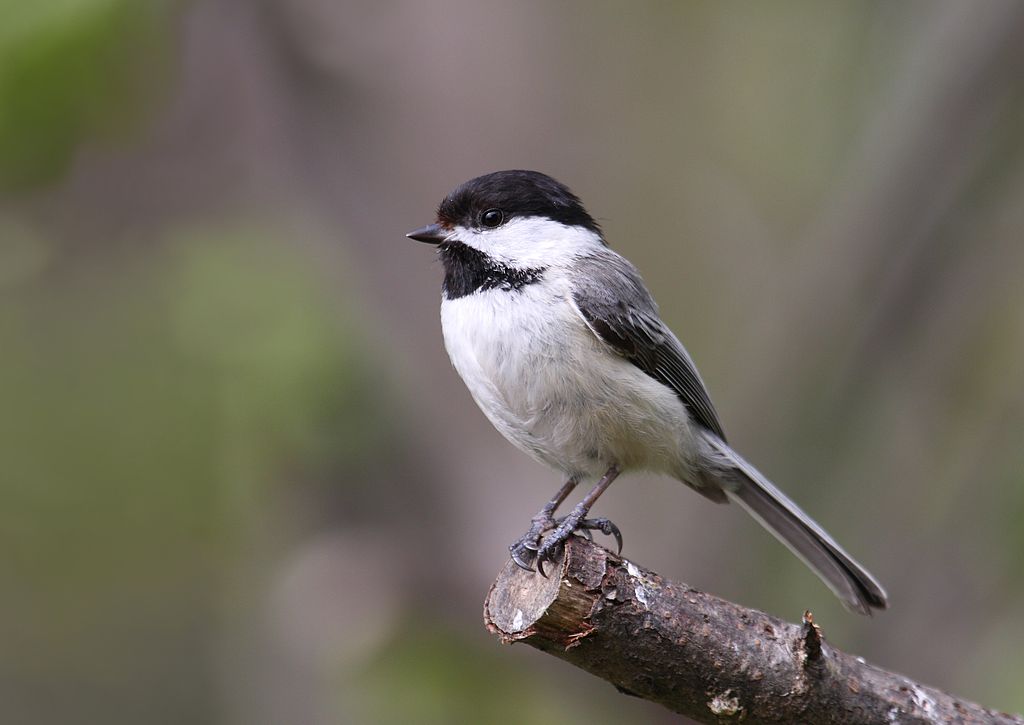
Coloration and Markings: Black-capped Chickadees have soft, gray backs with small, gray wings, and white-edging present. They have long, gray, and white edged tails and the underbelly and breast of this bird are white, flanked with the lightest of buff coloration. Facially, these birds have white cheeks and necks, as well as a small, black bib and a large, black cap which terminates vertically at mid-eye level. These birds have small, conical black bills.
Size: These birds measure in at 4.7 – 5.9 inches in length and have wingspans of 6.3 to 8.3 inches in width.
Habitat: While fond of Alder and Birch trees, these birds may be found just about anywhere that there are trees and dense, vegetative cover. These birds love marshes, overgrown fields, brushes, scrubs, brambles, and shrubberies where they may forage and feel relatively safe.
Diet: These Chickadees love peanut butter and suet, either separated or mixed. Try the latter style and see what happens, these birds just can’t get enough!
Mourning Dove – Zenaida macroura
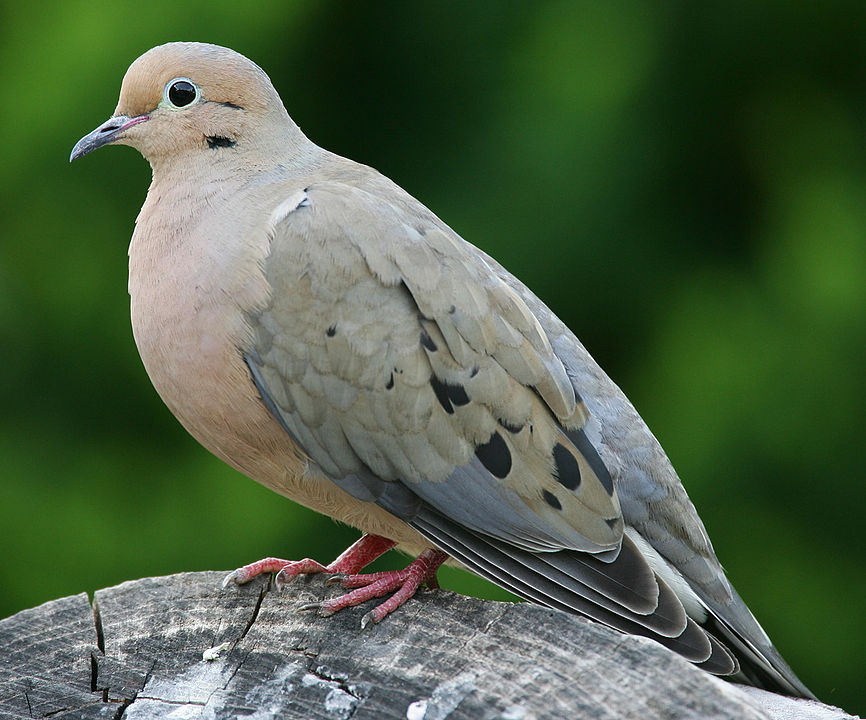
Coloration and Markings: Mourning Doves have gray backs with long, gray wings which have a heavy infusion of tan coloration present. You will also see some very distinct large, black spots towards the center of the wings, and these birds have long, pointy gray tails. The breast and underbelly of this bird are a base white with a mix of creamy tan, enough that you wil lonely see small hints of white poking around the edges, and facially, this bird is a buffy tan color that brings out a thin, white eyering that seals the identification. These birds have medium–length, straight black bills.
Size: These birds measure in at 9.1 – 13.4 inches from tip to tail and have wingspans of approximately 17.7 inches wide.
Habitat: While you might see them foraging on open, seemingly empty ground or in fields, that is about as close to nature as these birds get. They are not fond of the woods, but prefer human inhabited areas where the foraging is good. Look for them around town on sidewalks, fences, and phone lines as they scope out their next meals.
Diet: Cracked corn, wheat, and Black Oil Sunflower seeds are 3 favorite of the Mourning Dove. Be sure to leave a little out for them and you might make a lovely new best friend.
American Goldfinch – Spinus tristis

Coloration and Markings: Male American Goldfinches have bright, yellow backs with long, black wings and short, black tails which are distinctly notched. The wings will have 2 white wingbars each, as well as some assorted, mostly vertical white marks towards the wing’s centers and there will be white marks present on the tail as well. The rump of this bird is white and you will see some white on the undersides of the tail. The underbelly, breast, and face of this bird will be bright yellow, however, and this color is only broken twice on the face. The first instance is a small, black cap across the forehead and the second if a medium-length, conical orange bill. Females will have an olive coloration instead of black and their yellows will be somewhat muted and both genders will molt into brown plumage during the winter. At this time you can still dimly see their white wingbars to aide in identification.
Size: These birds measure in at 4.3 – 5.1 inches in length and have wingspans of 7.5 to 8.7 inches wide.
Diet: Nyjer thistle and hulled Black Oil Sunflower seeds are both favorites of the American Goldfinch.
Song Sparrow – Melospiza melodia
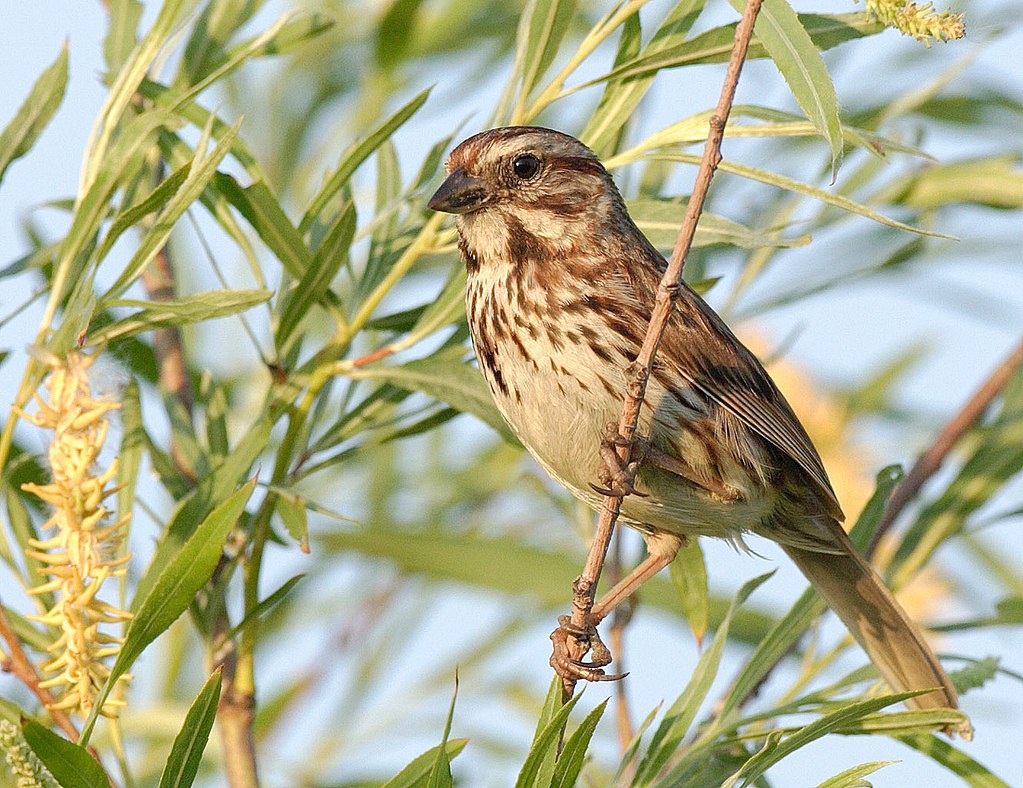
Coloration and Markings: Song Sparrows have gray backs with heavy brown streaking. They have small, but broad, brown wings with gray tips and long, brown tails which are quite animated and perky. The underbelly and breast of this bird will be light gray or white with brown streaks and facially, this bird has a mostly gray face with the exceptions of a white mustache line with a brown stripe above it, as well as a brown eyeline which goes to the back of the head and a warm, brown crown. This bird has a short, stout, and conical silver bill.
Size: These birds measure 4.7 – 6.7 inches from tip to tail and have wingspans of 7.1 to 9.4 inches wide.
Habitat: You can find Song Sparrows in a large number of environments, from desert washes to weedy fields, or even perched on cattails in a local marsh. They are frequent visitors to backyard feeders so be sure to leave a little something out for them.
Diet: Song Sparrows will be pleased if you add some shelled, crushed peanuts and suet cakes to the feeder. Give it a try and see for yourself, you’ll love the results!
American Robin – Turdus migratorius
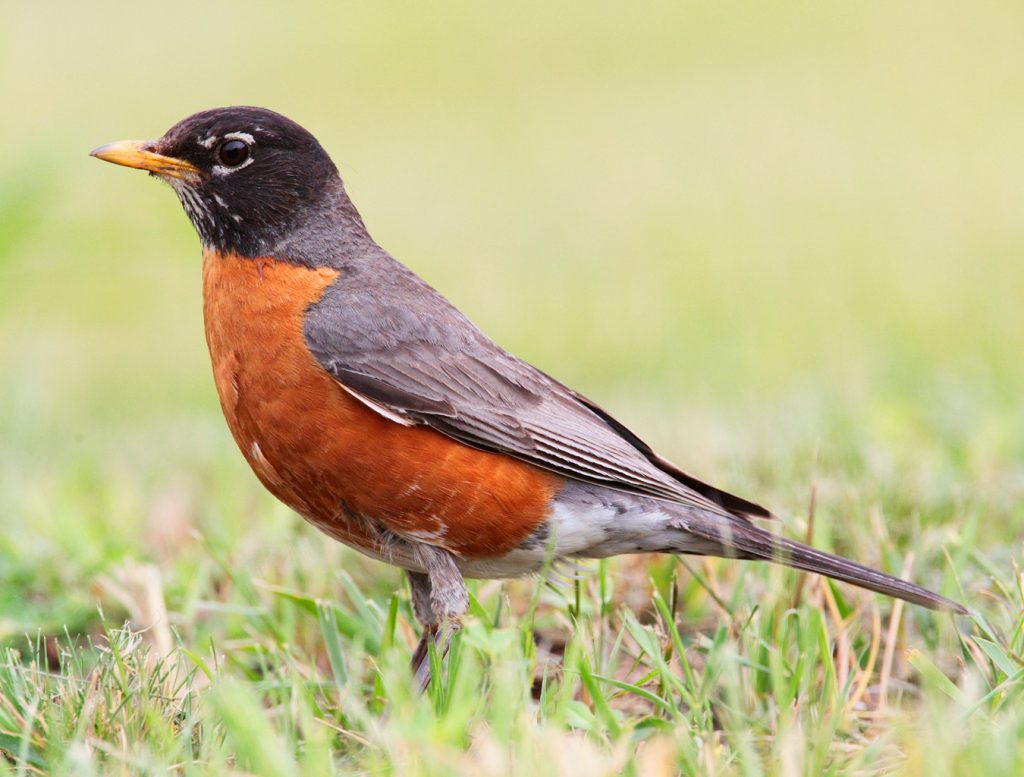
Coloration and Markings: American Robins have gray backs with long, gray wings and long, gray tails. When the bird is in flight you may notice a white patch towards the tail, as this bird has a white rump, but the underbelly and breast of this bird will be a reddish-orange color. Facially, Robins have black heads with a small tuft of white often present just underneath the medium-length, slightly curved yellow bill, and an eyering is present but it is distinctly ‘broken’ up into separate pieces that surround the eye. Females will have lighter colored heads and somewhat muted colors.
Size: These birds measure in at 7.9 – 11 inches in length and have wingspans of 12.2 to 15.8 inches in width.
Habitat: When they are in the woods these birds prefer the deciduous variety and they are also fond of pine stands. That said, they are frequent visitors to farms and cities where you can see them in places like golf courses, parks, orchards, and backyards with well-stocked feeders.
Diet: Crushed peanuts, chopped apples, and raisins are a great and healthy combination for luring the American Robin in to your backyard feeders.
North Dakota’s Birds of Spring, Summer, and Early Fall
The Prairie Crocus is the first wildflower to show itself at the start of Spring and things start to progress at a steady pace after this. A number of birds start to arrive and typically stick around until early fall. See if you can spot one of our examples during the warmer months:
- Clay-colored Sparrow
- Brown-headed Cowbird
- Chipping Sparrow
- Killdeer
- Black-billed Magpie
Clay-colored Sparrow – Spizella pallida

Coloration and Markings: Clay-colored Sparrows have tan backs with heavy dark brown streaking. They have medium-length wings and long tails which are the same color as the back and whitish-gray breast and underbelly. Facially, you will first notice a distinct gray color which is present throughout the year, making for an easy, quick identification even if this is your first time to see the bird. Facially, this bird has a grayish-white chin with a white mustache line that curves down and then upward to the back of the head. A white eyebrow line also crosses over the eyes and curves down where it meets the color. The cheeks will be tan surrounded by thin lines of dark brown and this Sparrow has a dark brown and tan crown as well. These birds have small, stout, and light colored bills.
Size: These little birds measure on-average 4.5 inches from head to tail and have wingspans of approximately 7.5 inches.
Habitat: These birds prefer dense cover, such as forest’s edges with brush, thickets, or shrubs where they can forage in relative safety. They are particularly fond of conifers but you can also see them around desert scrubs, grasslands, and overgrown fields, as these little guys and gals get around.
Diet: When they are not dining on insects, Clay-colored Sparrows like small seeds and berries. Try leaving out some Nyjer thistle and some whole fresh or dried Blueberries and you might just get their attention.
Brown-headed Cowbird – Molothrus ater

Coloration and Markings: Male Brown-headed Cowbirds are easy to identify. They have shiny black backs, with medium to long length wings and short tails of the same color. The breast and underbelly are black as well but this bird’s head is a light brown, with slightly darker coloration at the front of the head. These birds have thick, medium-length, conical black bills. Females have a much duller coloration, being light brown in color overall with tiny streaking marks at the underbelly and breast.
Size: Males and females will differ slightly in size, with males measuring in at 7.5 – 8.7 inches in length, while females average 6.3 – 7.9 inches. The male’s wingspan will typically average 14.2 inches in length while the female wingspan is between 12.6 to 15 inches.
Habitat: These birds love open areas such as meadows, pastures, and fields, where they forage on the ground and spend their rest and singing time in safety of lofty, nearby branches.
Diet: Cowbirds adore cracked corn, White Proso millet, and Sunflower seeds of any kind, but if you don’t want them at your feeders then put out things that they don’t like instead. Examples include suet, peanuts, and Nyjer thistle.
Chipping Sparrow – Spizella passerina
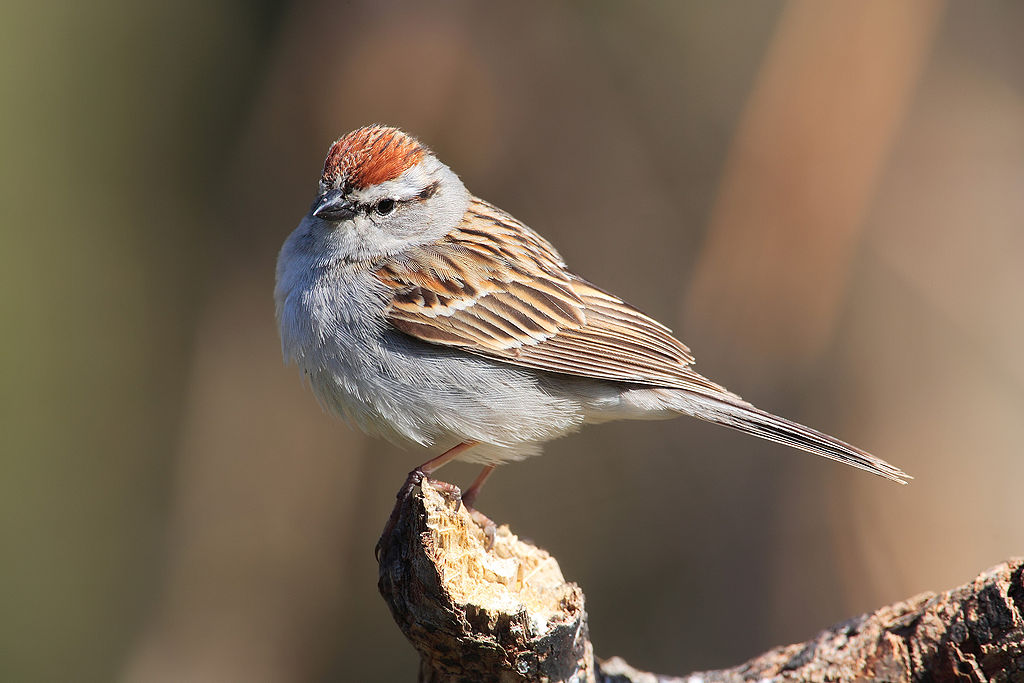
Coloration and Markings: The Chipping Sparrow has a tan back and medium-length wings, both of which have neat, dark brown streaking and long, gray tails. They have gray underbelly and breast, with the underbelly being lighter in color and sometimes exhibiting traces of tan. Facially, these birds typically have gray faces with a white chinline next to a white mustache line, both dim but present, and a thin, black eyeline that passes through the eyes and zigzags a little before terminating at the back of the head. These birds have a rich, brown crown, with some light peppering of white underneath and with some black at the front of the crown. These birds have stout, medium-length, conical black bills.
Size: These tiny birds measure in at 4.7 – 5.9 inches from head to tail and have wingspans of 8.3 inches wide.
Habitat: These birds love open areas, so look for them at the forest’s edge or in meadows, stands, or clearings. They do range out often, where you can spot them in parks, fields, and backyards with well-stocked feeders.
Diet: Rolled oats, cracked corn, suet, and any kind of sunflower seeds are all welcome to additions to your feeders as far as the Chipping Sparrow is concerned.
Killdeer – Charadrius vociferus

Coloration and Markings: Killdeer have a lovely plumage combination that is easy to recognize. They have tan or dark brown backs with long wings and tail of the same color, though there is some hard to see orange at the rump that should be noted as well. The tails will be white on the undersides, as is the breast and underbelly of this bird, though there will be a distinct crescent mark at the top of the breast with a black stripe which follows a little further upwards. The neck and face of this bird are white, with a few notable exceptions. Those are the brown cheeks and the top of the bird’s head, where there is a brown crown. The best part, however, it the ‘eyepatch’ mark that makes this bird look like a little pirate. It starts as a black stripe coming down from the top of the head, angling down to the eye, and then coming out the other side as a thin, black line that curls at the end. These birds has long, stout, and straight black bills.
Size: These birds measure in at 7.9 – 11 inches from head to tail and have wingspans of 18.1 to 18.9 inches wide.
Habitat: These little pirate-like birds are actually quite fond of open land, be it bare of chock full of shrub cover. It is not uncommon to see them in someone’s lawn, an overgrown field, or fishing for grub at a sandbar. Though they are seabirds, Killdeer definitely get around.
Diet: While the majority of their diet is going to be insects, fish, frogs, and crustaceans, these birds do occasionally eat seed and might nibble a suet cake. Try leaving out some hulled Black Oil Sunflower seeds and Nyjer thistle but use a ground feeder as that is how the Killdeer likes to forage.
Black-billed Magpie – Pica hudsonia

Coloration and Markings: Black-billed Magpies have black backs with white ‘backpack strap’ markings at the sides of the upper back. They have medium-length wings and quite long tails, both of which are a mix of blues and greens that look simply black from a distance. The rump of this bird is black but the underbelly and breast will be white, with the exception of a ’U’ – shape of black coloration that extends down from the head, giving this black-headed bird a hooded appearance. This bird has a long, stout black bill which is straight overall but displays a light curvature on the upper bill.
Size: These birds measure in at 17.7 – 23.6 inches in length and have wingspans of 22.1 to 24 inches in width.
Habitat: These birds like to be near ponds and streams but you can find them in feedlots, fields, parks, and backyards where they have been made to feel welcome.
Diet: These birds like suet, peanuts, and whatever fruit you have around (or even fast-food scraps!).
North Dakota’s Fall and Winter Birds
Temperatures in North Dakota during the winter can get as low as -60 degrees Fahrenheit, which is great news for snowmen but might be considered a bit harsh for the rest of us. Despite these robust chills a number of birds are still out and about, foraging and keeping warm when they can. Be sure to help a bird out by leaving something yummy for these frosty foragers this year:
- Blue Jay
- Dark-eyed Junco
- Downy Woodpecker
- Common Redpoll
- Brewer’s Blackbird
Blue Jay – Cyanocitta cristata
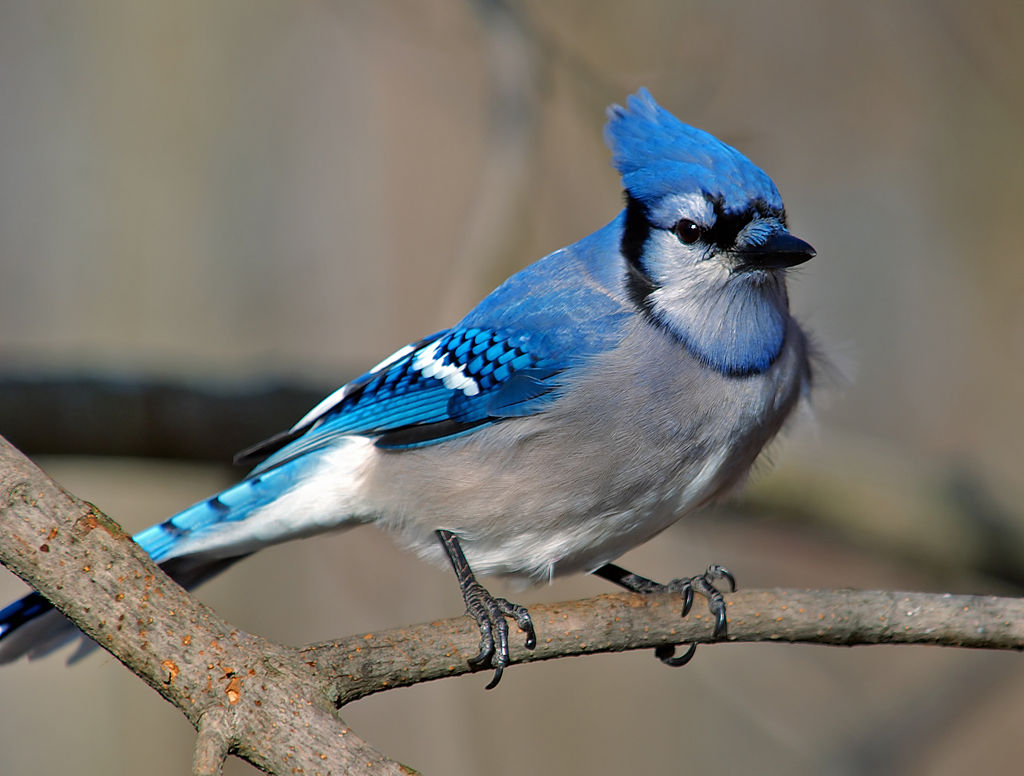
Coloration and Markings: Blue Jays have deep, blue backs with medium-length blue wings which display a scaling pattern of black-outlined blue just under the shoulder and above a black-outlined white wingbar. Further down and central on the inner-wing you can also see large, white spots, which are also outlined in black. These birds have long, blue tails as well, which will display a more symmetrical patterning of pairs of squares, made of light blue outlined in darker blue, along with some white, outer tailfeathers. They have white rumps, underbelly, and breast and this white carries up into the face, broken briefly by a black line that starts at the termination of the Jay’s majestic, blue crest and circles the base of the throat to the other side. Facially, this bird has a thin, zigzagging black mask and a long, straight, and stout black bill.
Size: About the size of a large Robin, these Jays measure in at 9.8 – 11.8 inches in length and have wingspans of 13.4 to 16.9 inches.
Habitat: These birds love the forest’s edge and are especially partial to Oak trees and their acorns! They do range out into parks and the cities quite frequently, however, so be sure to leave a little something out for them.
Diet: Blue Jays are easy to please, just leave out some Black Oil Sunflower seeds, suet, and peanuts if you’ve got some and you’ve got a recipe for happy Blue Jays.
Dark-eyed Junco – Junco hyemalis

Coloration and Markings: Dark-eyed Juncos are typically a dark brown or gray color on the upper 2/3 of their body. This includes their back, their medium-length wings, and their long tails, though the tail will display white undersides and some white outer feathers. The underbelly and breast of this bird are white with a flanking of gray or dark brown, which thickens as the color approaches the breast. Facially, they are dark brown or gray and have thick, conical, and medium-length pink bills.
Size: This bird measures in at 5.5 – 6.3 inches from tip to tail and has a wingspan of 7.1 to 9.8 inches wide.
Habitat: Dark-eyed Juncos are fond of coniferous and mixed-coniferous woods but they move to more open surroundings from time to time (especially in winter), visiting parks, fields, and backyards.
Diet: Juncos love cracked corn, White Proso millet, and hulled Black Oil Sunflower seeds. Be sure to leave 1 or more of these out in your feeder and you might just get the attentions of the Dark-eyed Junco.
Downy Woodpecker – Picoides pubescens
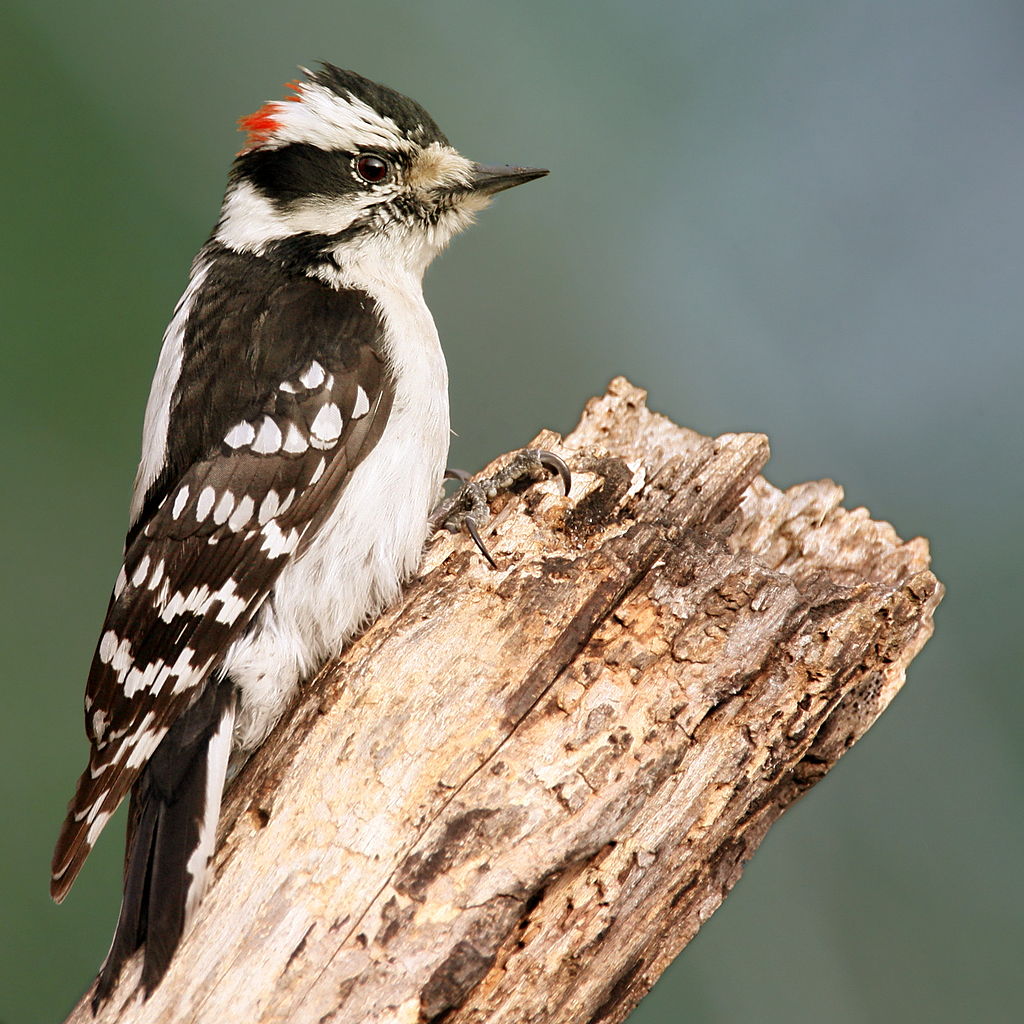
Coloration and Markings: Downy Woodpeckers have a white, white stripe on their backs and long, black wings as well as short, stiff, notched black tails. The wings will exhibit a spaced pattern of stripes starting just below the shoulder to the termination of the wings, and these stripes are made of blocky spots, giving it a checkerboard effect that really gets your attention. They have white outer tailfeathers, sometimes spotted, and the underbelly and breast of this bird are paper-white. This white extends up to take up the throat and most of the face, broken only by a black half-collar at the back of the neck, a black mustaches line, a black bandit-mask stripe, and a black crown. This crown will display a red spot at the back if you are looking at a male, but if there is no red then you’ve identified a Downy female. These birds have tubular, medium-length, black bills.
Size: Measuring in at 5.5 – 6.7 inches from head to tail and with wingspans of 9.8 to 11 inches, this is quite a small woodpecker. The smallest Woodpecker species in North America, in fact!
Habitat: Downies like deciduous woods, especially with brush or thicket cover present nearby. They have a sweet tooth as well, so you can spot them at orchards, gardens, and backyards with sweets in the feeders.
Diet: These cute little birds like Black Oil Sunflower seeds and will also eat suet cakes, provided that you put them in an easy-access wire mesh.
Common Redpoll – Acanthis flammea
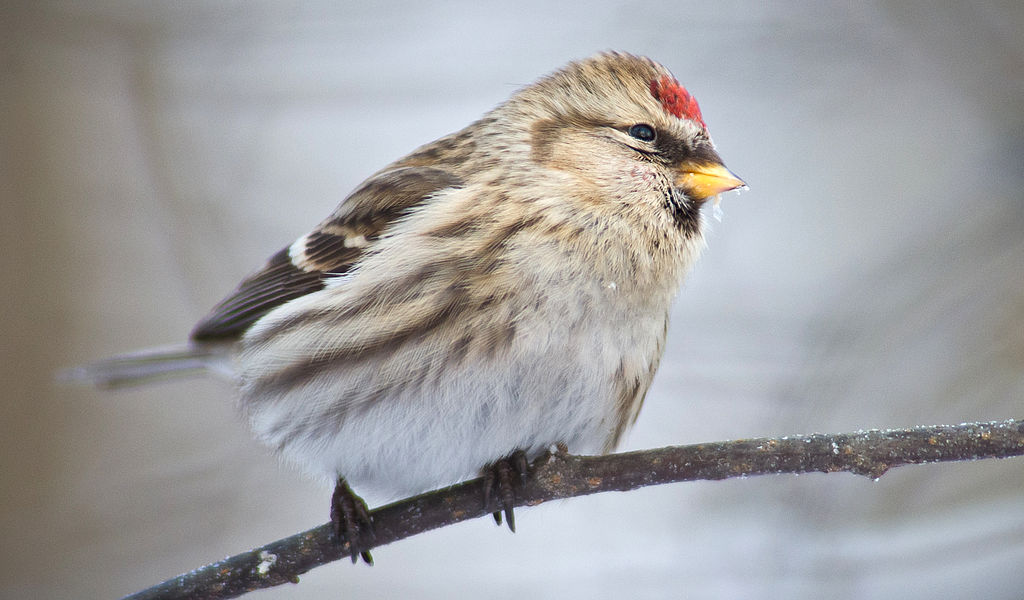
Coloration and Markings: Common Redpolls have brown, streaked backs with a number of white highlights. They have medium-length wings of the same color, with 2 white wingbars present, and they have short, notched tails. The underbelly and breast of this bird are white with some spaced brown streaking and facially, males will exhibit a raspberry coloration at the chin that goes down into the breast where it thins but still shows dimly at the flanks. The majority of the face is brown and white streaked with a dark red crown at the forehead. These birds have medium-length, straight yellow bills with a touch of brown sometimes present. Females will display a smaller, red crown but no red at the breast and chin.
Size: These birds measure in at 4.7 – 5.5 inches in length and have wingspans of 7.5 to 8.7 inches in width.
Habitat: Redpolls love the forest’s edge and other open areas such as meadows, copses, and overgrown fields. They have a preference for coniferous woods whenever possible but they do range out into parks and backyards quite often when foraging.
Diet: Nyjer thistle and hulled Black Oil Sunflower seeds are an easy combination that can attract Common Redpolls.
Brewer’s Blackbird – Euphagus cyanocephalus

Coloration and Markings: Brewer’s Blackbirds are plump and a shiny black all over. They have long, black wings and long tails, and facially you’ll quickly touches of blue in the black and captivating yellow eyes. They have stout, medium-length, conical black bills. Females will be brown, with their wings and tails being noticeably darker, while Juveniles will look like much lighter versions of the females.
Size: Roughly Robin-sized, males will measure in at 8.3 – 9.8 inches in length, with females averaging between 7.9 – 8.7 inches. Both genders have wingspans which average approximately 14.6 inches.
Habitat: These birds love open areas where there is a little dense cover, such as coastlines, forest edges, and overgrown fields. They do range out into more inhabited areas as well, so you can sometimes spot a Brewer’s Blackbird at a golf course, park, or a backyard feeder that’s been thoughtfully laid out.
Diet: Cracked corn and White Proso millet are good choices for the Brewer’s Blackbird, as the bird loves them and they are less popular with songbirds. This means that there is a little specialized food for everyone.
Supporting cast (Other Backyard Birds of North Dakota that might pay you a visit)
While they didn’t make the fancy front page listing, these Supporting cast birds are celebrities all on their own and ready to please you with their songs and antics at any time of the year. Give a little love to one of these Supporting cast birds if you spot one:
- Common Grackle
- House Sparrow
- Hairy Woodpecker
- Horned Lark
- White-breasted Nuthatch
Common Grackle – Quiscalus quiscula
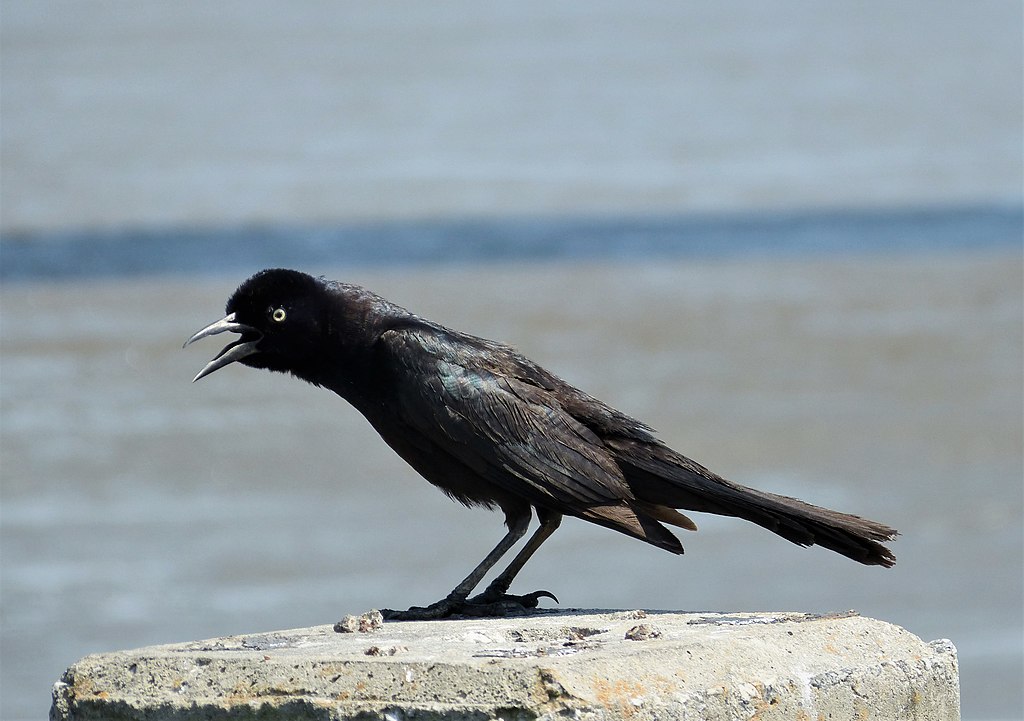
Coloration and Markings: The inquisitive and clever Common Grackle looks like any old Blackbird from a distance but up close you will notice that its head has a blue-hooded look, while the rest of the body is more of a bronze color. They have long wings and even longer tails and facially, you’ll notice their golden eyes unless the Grackle is a juvenile, in which case the eyes will be dark. Females are less shiny and these birds have long, stout black bills with a very minute downward curvature present.
Size: These birds measure in at 11 – 13.4 inches from head to tail and have wingspans of 14.2 to 18.1 inches.
Habitat: Grackles love fields and feedlots, but they are also quite often foraging in your front or back yard. When they are in the woods they prefer open areas, such as meadows and clearings, and they do have a fondness for foraging near ponds and marshes as well.
Diet: It would be easier to list all of the things that Grackles WON’T eat, but they especially love Sunflower seeds of any kind and suet and will gobble them all down if they see them. If this is problematical you can use feeders that hide the suet but these birds are clever — results may vary.
House Sparrow – Passer domesticus

Coloration and Markings: House Sparrows have graish backs with short, brown wings with black streaking and short tails of the same coloration. The underbelly and breast of this bird are a dirty gray and facially, you’ll notice a black bib that drips down black color well into the breast. The cheeks and collar are white while an eyestripe which starts black in front of the eyes becomes a rich-brown stripe that curls around to frame the cheeks. The crown of the bird is silvery gray and these Sparrows have stout, short, black bills with a light but noticeable curve in the upper bill. Females will be lighter in color, with a mix or browns and tans in the wings and tail, lighter breast and underbelly, and a tan eyestripe that does not curve along with a tan collar.
Size: These little birds measure in at 5.9 – 6.7 inches in length and have wingspans of 7.5 – 9.8 inches in width.
Habitat: These smart little birds have been around us for awhile so they know that they can get handouts at zoos, parks, and backyard feeders. When they aren’t in the city you’ll find them not in the woods or even overgrown fields, but at farms where they can sample animal feed until they get their fill.
Diet: These birds like to eat nuggets of suet and shelled peanuts, so leave a little something out for your new little friends. It’s easy and oh, so rewarding.
Hairy Woodpecker – Dryobates villosus
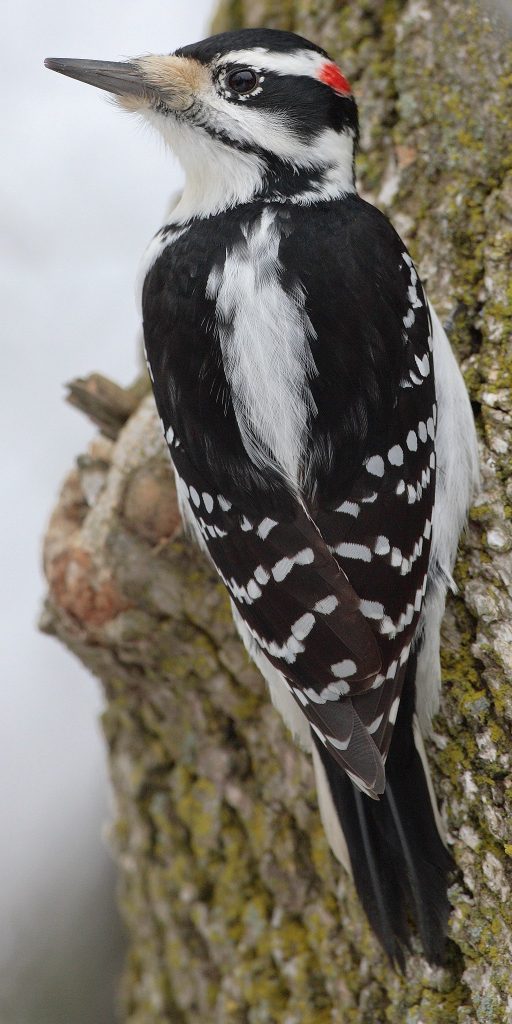
Coloration and Markings: Hairy Woodpeckers look a lot like larger Downy Woodpeckers. They have a white stripe on their backs with long, black wings displaying blocky, white spots arranged in spaced stripes, but they do have longer, black, notched tails which will have some white on the undersides. The underbelly and breast of this bird are white as well and the face will be black except for white on the chin and a white stripe above and below the eyes. A red spot will display at the back of the head if you are looking at a male. These birds have long, thin, black bills which are occasionally minutely upturned but more often are simply straight.
Size: These birds measure in at 7.1 – 10.2 inches In length and have wingspans of 13 to 16.1 inches wide.
Habitat: These birds love the woods, especially older woods, where they tend to favor trees such as Pine and Oak. You can find them in many other places, however, such as cemeteries, woodlots, parks, and backyards.
Diet: These Woodpeckers like to visit feeders for suet and Sunflower seeds of any kind.
Horned Lark – Eremophila alpestris

Coloration and Markings: Horned Larks have reddish-brown or sandy colored backs with medium-length wings and long, brownish tails which are edged in black. The underbelly and breast of this bird are white with a flanking of reddish-brown or sandy color that thickens as the color moves up the breast and facially, they will be white or yellow with a black line across the base of the throat, as well as a thick, black eyestripe that passes the eyes and immediately curves downward, and a black line encircling the forehead, which often ends in small tufts that resemble horns. These birds have thin, short bills which are black and sometimes have a touch of white and females will exhibit the same coloration, albeit somewhat muted.
Size: These birds measure in at 6.3 – 7.9 inches in length and have wingspans of 11.8 to 13.4 inches wide.
Habitat: Desert, tundra, or simply open ground, these birds like areas which are open and bare. You can sometimes find them in other areas where there is a bit of scrub but overall they like an open, clear view of their surroundings while they forage.
Diet: Horned Larks eat mostly insects and seeds, so leave out a mix of Nyjer thistle and hulled Black Oil Sunflower seeds if you are trying to tempt one to come in for a closer look.
White-breasted Nuthatch – Sitta carolinensis

Coloration and Markings: White-breasted Nuthatches have silvery-blue backs and long, silvery-blue wings with black highlights and a very thin white wingbar on each wing. They have short, bluish-gray tails which are white on the undersides and a white rump, underbelly, and breast, though you will often notice a distinctive rust-red mark at the underbelly. Facially, these birds have white faces with a slanting black line going from the top-back of the eyes and a black cap that extends to the nape of the neck. These birds have long, straight bills which are often black on top and whitish colored below.
Size: These birds measure in at 5.1 – 5.5 inches in length and have wingspans of 7.9 to 10.6 inches in width.
Habitat: These birds love older woods but they also hang out at the forest’s edge. They are particularly fond of deciduous areas and favor Oak, Maples, and Hickory trees among a few others. They sometimes venture into coniferous forests but the deciduous are greatly preferred.
Diet: These birds love suet, just be sure to use a cage-style feeder so that they can easily spot and take advantage of this high-energy snack.
North Dakota Bird Buffet
When you want to make sure that your feeder is well equipped for the local birds it is always a good thing to consider a little expert advice. Today we are sharing some tips from the North Dakota 4-H Nature Trails in this regard and we’ll toss in some recommendations of our own. Between the two you should have a good starting point and if you’d like to read the whole article from the North Dakota 4-H just check out references. In the meantime, consider adding one or more of these foods to your feeder:
- Beef suet
- Nyjer thistle
- Cracked corn
- Grain Sorghum
- Grape Jelly
North Dakota Birding Hot Spots
When you are looking for a little bit of adventure, why not take some time out and go to see some new birds nearby in their native element. The Chirparazzi know all the places for getting glimpses and taking photos of your favorite winged celebrities and today they will share a few which we think that you will like. Try taking a little visit to one of these locations:
- Northern hotspot – Tatman Branch Trail
- Eastern hotspot – Northern Cass Pass
- Southern hotspot – Roughrider Trail
- Western hotspot – Fairview Bridge & Cartwright Tunnel Trail
- Central hotspot – Hay Creek Trail (ND)
Detailed descriptions of each location as well as information regarding visiting and what birds you can see at these locations may be found at https://www.traillink.com/stateactivity/nd-birding-trails/
In Closing
Today we have taken a brief foray into the great birding journey that is North Dakota. Exploring the state is rewarding and with so many birds and new locations to see you can keep yourself quite busy birding in the Peace Garden state. So ready your gear and pack a big lunch, it’s time for a little birding! Until next time, we wish you the best!
